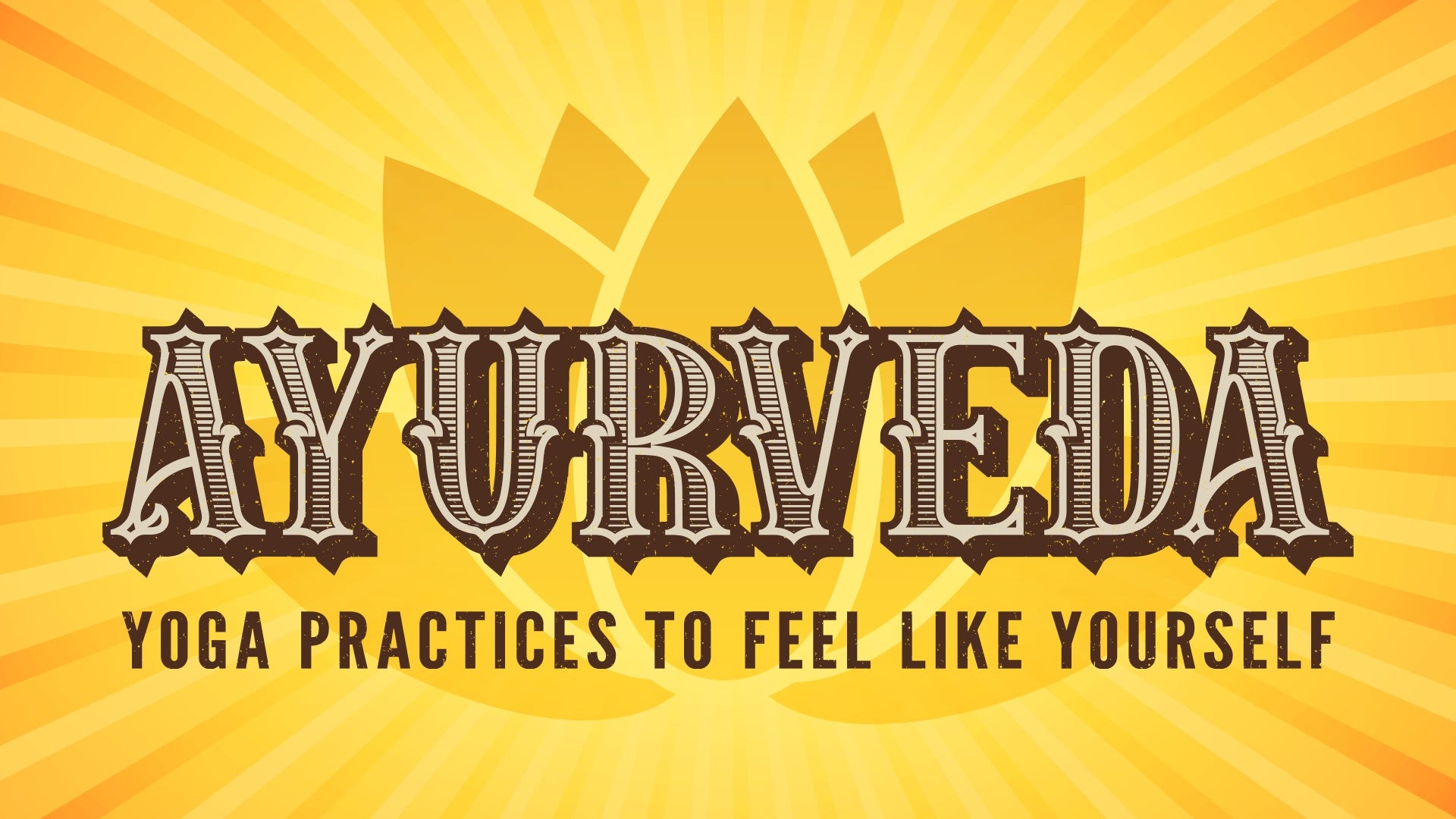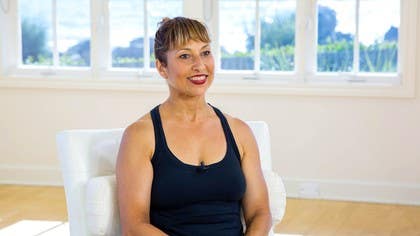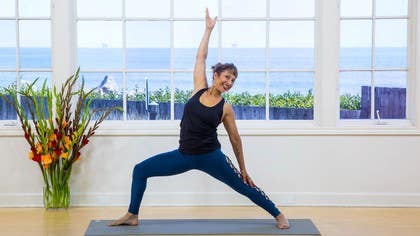Description
About This Video
Transcript
Read Full Transcript
Prana is life force, and a lot of times people think that prana is the breath, prana is not the breath, prana is the energy that lives in our breath. So when we practice asana, it's a way of utilizing prana and encouraging prana to move through the body and that is going to make us feel good, the values. The values are different energies within the body, so you can think of them as serving the master of prana. Let's think of it this way, if prana is the overall life force within the body, then it's prana with a big P, with a capital P. Think of these as like the little pranas, the five values or the winds are the little pranas and they actually are the energies that move the main prana around in the body in different directions and so every time that we step forward into warrior one and inhale the arms up, we're moving prana within the body.
And the Ayurvedic perspective is that when we do get out of balance, it's actually not the body that gets out of balance, it's the prana that's impeded. In some way it's stuck somewhere and that creates issues for the body but it starts with the subtle body, it starts with the energetic body. Udana vayu is the energy or the wind that moves in the throat and up into the head and this energy moves up and out. So if you think about when we talk every day, the way that we communicate every day of getting our truth out, udana vayu is responsible for that. So when I was in Ayurveda school, my teacher, Maya Tiwari, every morning she would tell us that we needed to take water and hold it in our mouth and swirl it around and then spit it as hard as we could out in order to get udana vayu going in the morning so that our truth would come out easily and our speech would come out easily.
So whenever I think about udana vayu, I always think of every morning spitting into my sink and making a big mess in the best way. Prana vayu is the energy that lives in the heart and moves up towards the head. So in the same way that udana vayu moves up and out, prana vayu moves up and in. And you can think of this prana as being prana with a little P. I said before that the main prana is prana like with a capital P. That's the overseer of all of it. And these are the forces that move prana around in the body.
So prana vayu lives in the chest and it governs our inhale, the way that we take things in and also our forward moving energy. So prana is responsible to keep us going in the direction that we need to go to be open to stepping into the next phase. So if you are feeling a little depleted, a little worn down, exhausted, if immunity is down, it's interesting to just pay attention to whether we're inhaling properly. Like are we taking in the energy that we need in order to then give it back out? Has to be a balance of both.
Samana vayu lives in the belly and it governs digestion. So this is the way that we take everything in that we assimilate and it's like drawing everything from the edges back into the middle where it can be processed and utilized and separated into what feels like nutrition and what feels like we need to let it go. It also governs the way that we even process information because it's third chakra and third chakra has to do with how we see, with how we take things in. Are we seeing the truth? Are we getting what we need from the way that we observe things in the world?
So Samana vayu is very important to feel centered, to stay strong and to have a sense of self. If Samana vayu is out of balance, we'll feel like we're kind of all over the place. Like nothing is really coming together properly, which is why I feel like in our asana practice, having a strong sense of core and that doesn't necessarily mean like, you know, do a bunch of crunches or get really rock hard abs, right? That's not, we want to have an equal give and take of strength and also mobility so that whatever comes our way, we can assimilate it, we can take it in and we can find the nutrition in it. Apana vayu is the energy that lives in the pelvis and this is responsible for governing downward moving energy down and out of the body.
So obviously this governs elimination of all kinds. This is what helps women push out a baby in childbirth or to have a menstrual cycle. If it's not working well, we're going to feel a little spacey, a little ungrounded. It'll be hard to get rid of anything. We'll be up in our heads and sort of not present on the earth and I think it's so important these days because so much of our world is about technology and it can get us up in our heads to really feel that earthly connection.
So doing those poses in our asana practice that are lower, on the ground, taking the time to slow down a little is so important. Viyanavayu and now we come to Viyanavayu. The fifth wind is the one that is responsible for circulation. So there's no real isolated place that we find it like the other vayus. Viyanavayu is meant to be all through the body.
So this is what makes us feel alive, what keeps circulation going, what keeps us feeling full of energy. What I love to cultivate Viyanavayu in the body is moving a little bit faster because my natural inclination is to move slower. So sometimes it's actually good to get things speeding up a little bit, to move through some of the practices that really are designed to speed what's called venous return and venous return is when blood goes back to the heart and gets oxygenated and then moves through the body. One of the best ways actually to get that venous return working is to go upside down. And we do it so much in our practice.
Every down dog is an inversion. Every uttanasana standing forward bend is an inversion. So whether you actually take your feet off the ground or not, it doesn't matter. If your heart is above your head, you're getting some of that Viyanavayu going. So why would these be important in our lives?
Why would they be important in our yoga practice? When we have a balance of all of the winds working properly, anything that comes our way, anything that comes up, we're able to move with finesse, we're able to make our way through life, feeling grounded, feeling energized, feeling centered, feeling like speech comes easily, like we can express ourselves. There's so many different benefits to feeling these winds, these energies moving through the body in a way that one never takes priority over the other. So in our yoga practice, we're always looking to balance out. We might have an excess of one, then we cultivate the opposite.
If we have too much upana, maybe we work on udana. If we have too much viana, maybe we work on samana. So every time, actually, that as a yoga teacher or a yoga practitioner, we think about using dual actions for balance. So for example, in using the vayus in a yoga practice, we might use upana vayu to come down into a squat, but then udana vayu to lift up the sides of the waist, to extend the sides of the neck, even to feel the lift in the tops of the ears. And that way, we're balancing out the energy.
It's never too much of one thing in one direction or too much of another thing in this direction. We're using this subtle balance of the different winds to feel like we're not overdoing in any way, like we can find this state of balance of yoga. So what is the relationship of the vayus to Ayurveda? Well, Ayurveda is all about finding balance in our lives and having what is inside of us harmonize with what is outside of us. Using the vayus is a way of actually doing that.
It's a way of following the rules, so to speak, of Ayurveda to feel like we're more in tune with the circumstances that we find ourselves in. It's medicine. That's what it is. The vayus are medicine, and they're natural medicine that you find in your body. They're there for you and available to address any issues that you might have.
It's natural medicine. I really think that working with the vayus is a way of taking our practice, our asana practice to the next level. Yes, it's a bit more subtle. It's a bit more internal. You might have to dig deep to really feel that within the body.
And I also think that once you start to cultivate that awareness, then it brings the practice together with both the external, physical world and the internal and subtle world.
Ayurveda: Practices to Feel Like Yourself: The Vayus
Comments
You need to be a subscriber to post a comment.
Please Log In or Create an Account to start your free trial.













